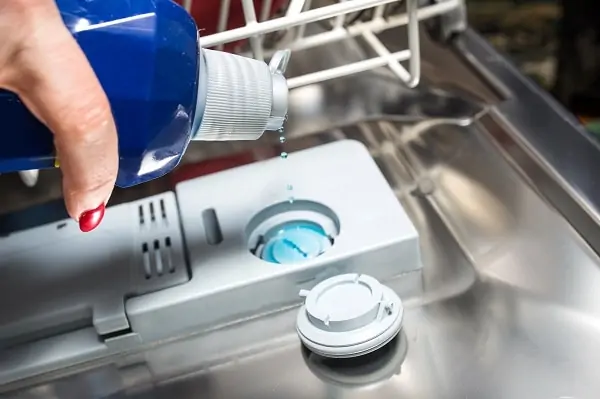
A Comprehensive Guide to Using Rinse Aid in Dishwashers
What Is Rinse Aid, And Can Your Dishwasher Live Without It?
If you’re tired of finding spots and streaks on your freshly washed dishes, you’re not alone. The solution to achieving truly sparkling and spotless results lies in a small but mighty helper: rinse aid. In this comprehensive guide, we will delve into the world of rinse aid for dishwashers, providing you with expert insights, step-by-step instructions, and invaluable tips to make your dishes shine like never before.
Embracing the Magic of Rinse Aid
When it comes to achieving impeccably clean and gleaming dishes, rinse aid plays a vital role. This often underestimated liquid assists in the drying process by reducing water spots, streaks, and residue on your glassware, cutlery, and plates. By breaking the surface tension of water, rinse aid ensures that every drop slides off your dishes, leaving them crystal clear and spot-free.
The Science Behind Rinse Aid: How Does It Work?
Rinse aid contains special surfactants that lower the surface tension of water. This prevents water droplets from clinging to your dishes during the final rinse cycle. Instead, the water forms a thin, even sheet that quickly drains away, taking with it any remaining detergent, minerals, or impurities. The result is a brilliant shine that enhances the appearance of your tableware.
Step-by-Step Guide: Using Rinse Aid Like a Pro
Adding Rinse Aid
To reap the full benefits of rinse aid, follow these simple steps:
- Open the dishwasher door after the final rinse cycle.
- Locate the rinse aid dispenser, typically located near the detergent compartment.
- If empty, unscrew the rinse aid cap.
Filling the Dispenser
- Pour the rinse aid into the dispenser, using a funnel to avoid spills.
- Fill until the indicator reaches the “Full” level.
Adjusting the Dosage
Modern dishwashers often have adjustable rinse aid settings. Consult your dishwasher’s manual to set the appropriate dosage for your water’s hardness.
Top Tips for Optimal Usage
- Regularly check the rinse aid level and refill as needed.
- Opt for a rinse aid that suits your dishwasher’s brand and model.
- Experiment with different dosage settings to find the one that delivers the best results for your water conditions.
Advantages of Using Rinse Aid
By incorporating rinse aid into your dishwasher routine, you stand to benefit in various ways:
- Spotless Results: Say farewell to water spots and streaks for dishes that dazzle.
- Faster Drying: Enjoy dry and ready-to-use dishes straight from the dishwasher.
- Reduced Maintenance: Rinse Aid helps prevent mineral buildup in your dishwasher, extending its lifespan.
Common Myths Debunked: Separating Fact from Fiction
Myth 1: Rinse Aid is Only for Hard Water Areas
Contrary to popular belief, rinse aid benefits both hard and soft water regions. It enhances the drying process, leading to improved results regardless of water hardness.
Myth 2: Rinse Aid is Unnecessary with Modern Detergents
While modern detergents are effective, rinse aid complements their action by ensuring thorough rinsing and drying.
Myth 3: More Rinse Aid, Better Results
Using too much rinse aid can actually lead to a cloudy film on your dishes. Follow manufacturer guidelines for optimal usage.
See more: Bleach in the Dishwasher
FAQs About Using Rinse Aid in Dishwashers
Q: Can I use vinegar as a substitute for rinse aid?
Vinegar can be used as a makeshift rinse aid, but it may not provide the same consistent results. Rinse Aid is specifically formulated for dishwashers and is more effective in preventing water spots.
Q: How often should I refill the rinse aid dispenser?
The frequency of refills depends on your dishwasher’s usage and the hardness of your water. Check the dispenser regularly and refill when the level is low.
Q: Can I use rinse aid in every wash cycle?
Yes, rinse aid is safe for regular use. It’s designed to be used in each dishwasher cycle to maintain optimal results.
Q: My glassware still has spots after using rinse aid. What should I do?
If you notice spots, adjust the rinse aid dosage or try a different brand. Also, ensure that your dishwasher’s spray arms are not clogged and that you’re using an appropriate detergent.
Q: Is rinse aid safe for the environment?
Most rinse aids on the market are biodegradable and environmentally friendly. Check the product label for information on its eco-friendliness.
Q: Can I use rinse aid in my dishwasher’s pre-rinse cycle?
It’s not necessary to use rinse aid in the pre-rinse cycle. Modern dishwashers are designed to effectively distribute rinse aid during the final rinse.
Elevate Your Dishwashing Game with Rinse Aid
In conclusion, if you’re aiming for spotless, gleaming dishes that impress, incorporating rinse aid into your dishwasher routine is a game-changer. By harnessing the science of surface tension and water behavior, rinse aid ensures that your dishes emerge from the dishwasher not only clean but also brilliantly shiny. Say goodbye to water spots and hello to a new level of dishwashing excellence.
Remember, achieving the best results may require a bit of experimentation to find the perfect rinse aid dosage for your specific water conditions. With the insights and tips shared in this guide, you’re well-equipped to make the most of this powerful dishwashing ally.